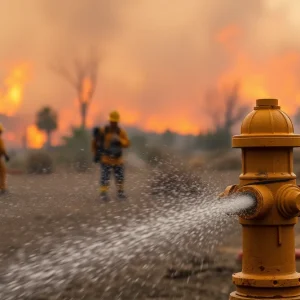McCook Lake Residents Seek New Flood Plan in Wake of Devastating Damage
State officials face criticism over handling of historic flood event, while residents plead for a change in mitigation strategy
Residents of McCook Lake in southeastern South Dakota are calling for a new flood mitigation plan, following damage sustained by historic flooding in June 2024. Community members, who believe their homes were sacrificed for the benefit of North Sioux City and Dakota Dunes, accuse state and local authorities of not providing sufficient warning against the impending floodwaters.
Government officials countered this criticism, arguing they had executed a long-established flood mitigation plan, which was unfortunately overwhelmed by unprecedented water volumes. While defending their communication, they stated that residents had received several warnings before the onset of flooding. The disaster has prompted deep cleanup operations and provoked questions concerning future flood management.
Speaking on behalf of the community, Dirk Lohry, president of the McCook Lake Association, expressed a need for a new flood mitigation plan. “McCook Lake was sacrificed for the benefit of North Sioux City and Dakota Dunes,” Lohry said. “We don’t really think that’s fair.”
The Crisis and Response
Triggered by three days of historic rainfall around areas as far as 140 miles north of McCook Lake, the crisis began when a tide of high water swept southward down the Big Sioux River, toward its convergence with the Missouri River.
North Sioux City, located downstream in the southeast corner of South Dakota, launched its decades-old flood mitigation plan, which includes constructing temporary levees across Interstate 29 near the McCook Lake community. The hastily constructed levee was designed to reroute floodwaters towards McCook Lake and away from North Sioux City and Dakota Dunes.
Despite similar measures being successfully implemented in the past, the volume of water descending Big Sioux River during this event was unprecedented. Early on Monday morning, river water levels measured at Sioux City peaked approximately 45 feet – over 7 feet higher than the previous record set in 2014 – causing what Lohry described as “absolutely devastating” consequences.
Debate Over Adequate Warning
The inadequacy of these warnings is the subject of a heated debate among homeowners. No urgent verbal warning regarding the safety of lake residents was issued at a pre-flood press conference that included Gov. Kristi Noem alongside federal, state, and local officials. While a voluntary evacuation order was issued by Dakota Dunes, no such directive was given for McCook Lake.
Residents felt that the messages they did receive were too little, too late. One McCook Lake resident, Tyler Wood, reported dodging the flood with his vehicle with barely a minute to spare. He stated that the only warning he received came from his neighbor, advising him to remove belongings from his basement about two hours before the flooding began in earnest.
Wood called for swifter communication in future events, stating, “Any communication would have been beneficial instead of less than two hours prior to knowing that our house would maybe be a loss. I know it’s hard to deliver on that, but finding out from neighbors in this situation just isn’t the best way to find out.”
Looking to the Future
As the community looks to the future, the sentiment seems to be in favor of a changed flood mitigation strategy. Lohry called for revision of the current plan, suggesting the diversion of floodwaters from Big Sioux around McCook Lake to nearby Mud Lake, which is not lined by houses. This could allow the water to overflow there and drain via the state’s Adams Homestead and Nature Preserve down to the Missouri River.
“It requires some thought, but considering the expense of what we’ve gone through right here, I think the plan needs to be revised,” Lohry said. “I think there’s a more economical and safer way to do it.”






